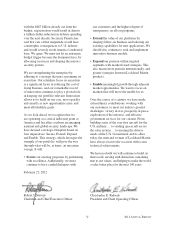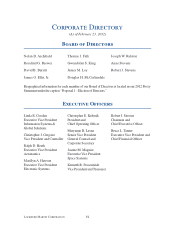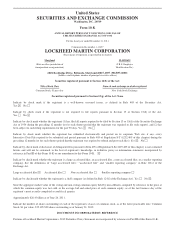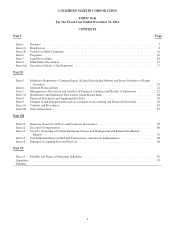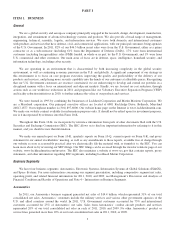Lockheed Martin 2011 Annual Report Download - page 16
Download and view the complete annual report
Please find page 16 of the 2011 Lockheed Martin annual report below. You can navigate through the pages in the report by either clicking on the pages listed below, or by using the keyword search tool below to find specific information within the annual report.Backlog
At December 31, 2011, our total backlog was $80.7 billion compared with $78.4 billion at December 31, 2010. Backlog
is converted into sales in future periods as work is performed or deliveries are made. Approximately $31.0 billion, or 38%, of
our total 2011 year-end backlog is expected to be converted into sales in 2012.
Our backlog includes both funded (unfilled firm orders for our products and services for which funding has been both
authorized and appropriated by the customer – Congress, in the case of U.S. Government agencies) and unfunded (firm
orders for which funding has not been appropriated) amounts. We do not include unexercised options or potential indefinite-
delivery, indefinite-quantity (IDIQ) orders in our backlog. If any of our contracts were to be terminated, our backlog would
be reduced by the expected value of the remaining terms of such contracts. Funded backlog was $55.1 billion at
December 31, 2011 as compared to $56.6 billion at December 31, 2010. The backlog for each of our business segments is
provided as part of Management’s Discussion and Analysis of Financial Condition and Results of Operations – “Discussion
of Business Segments.”
Research and Development
We conduct research and development activities under customer-funded contracts and with our own independent
research and development funds. Our independent research and development costs include basic research, applied research,
development, systems, and other concept formulation studies. These costs generally are allocated among all contracts and
programs in progress under U.S. Government contractual arrangements. Corporation-sponsored product development costs
not otherwise allocable are charged to expense when incurred. Costs we incur under customer-sponsored research and
development programs pursuant to contracts are included in net sales and cost of sales. Under certain arrangements in which
a customer shares in product development costs, our portion of the unreimbursed costs is expensed as incurred. Independent
research and development costs charged to costs of sales were $585 million in 2011, $639 million in 2010, and $717 million
in 2009. The downward trend reflects the transition of programs from development to production and the realignment of our
costs to adjust to our customers’ budgetary constraints. See “Research and development and similar costs” in Note 1 –
Significant Accounting Policies.
Employees
At December 31, 2011, we had approximately 123,000 employees, over 95% of whom were located in the U.S. We have
a continuing need for numerous skilled and professional personnel to meet contract schedules and obtain new and ongoing
orders for our products. The majority of our employees possess a security clearance. The demand for workers with security
clearances who have specialized engineering, information technology, and technical skills within the aerospace, defense, and
information technology industries is likely to remain high for the foreseeable future, while growth of the pool of trained
individuals with those skills has not matched demand. As a result, we are competing with other companies with similar needs
in hiring skilled employees in areas of need.
Approximately 15% of our employees are covered by any one of approximately 70 separate collective bargaining
agreements with various unions. A number of our existing collective bargaining agreements expire in any given year.
Historically, we have been successful in renegotiating expiring agreements without any material disruption of operating
activities. Management considers employee relations to be good.
Forward-Looking Statements
This Form 10-K contains statements that, to the extent they are not recitations of historical fact, constitute forward-
looking statements within the meaning of federal securities law. The words believe, estimate, anticipate, project, intend,
expect, plan, outlook, scheduled, forecast, and similar expressions are intended to help identify forward-looking statements.
Statements and assumptions with respect to future sales, income and cash flows, program performance, the outcome of
litigation, environmental remediation cost estimates, and planned acquisitions or dispositions of assets are examples of
forward-looking statements. Numerous factors, including potentially the risk factors described in the following section, could
affect our forward-looking statements and actual performance.
ITEM 1A. RISK FACTORS
An investment in our common stock or debt securities involves risks and uncertainties. We seek to identify, manage,
and mitigate risks to our business, but risk and uncertainty cannot be eliminated or necessarily predicted. You should
consider the following factors carefully, in addition to the other information contained in this Form 10-K, before deciding to
purchase our securities.
8



